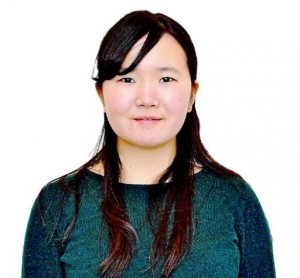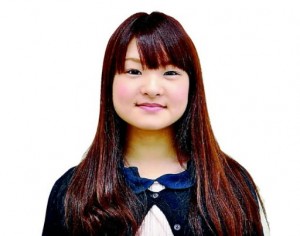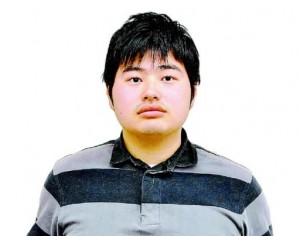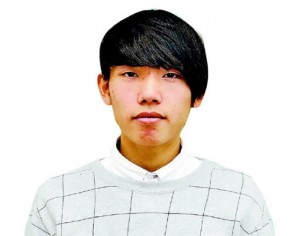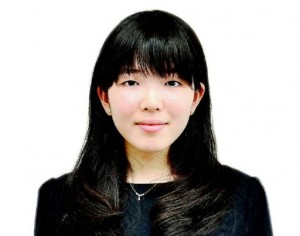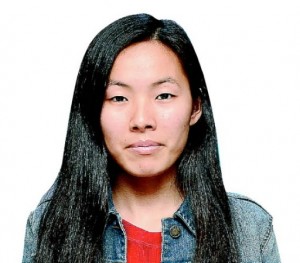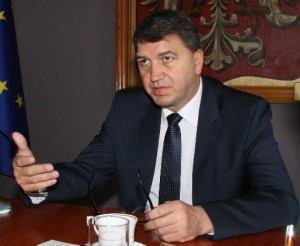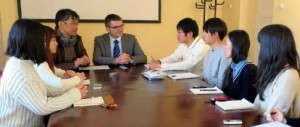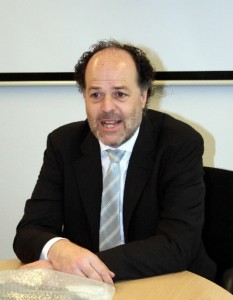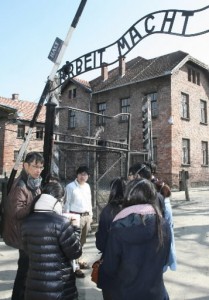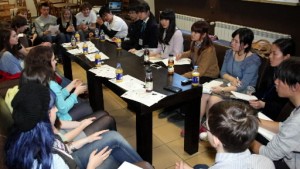College students from Hiroshima share impressions of study tour to learn about Holocaust, vow to act for peace
Apr. 28, 2015
In this milestone year, which marks the 70th anniversary of the atomic bombings and the end of World War II, six university students from Hiroshima Prefecture traveled to Europe to learn about the Holocaust (the genocide of the Jewish people). They were members of a study tour sponsored by the Hiroshima Peace Creation Fund.
Along with two high school students who are “junior writers” for the Chugoku Shimbun, the college students visited the site of the former Auschwitz concentration camp in Oswiecim, Poland. At the Auschwitz-Birkenau State Museum, the camp buildings from that time, and artifacts of the victims, are preserved and exhibited. The mayor of Oswiecim stressed the importance of the individual in promoting peace. After heading to Amsterdam, the Netherlands, the group of young people visited the house where Anne Frank lived in hiding. Through the tour, they renewed their determination to make efforts to promote peace.
Main activities of the study tour (March 22 to 29)
Oswiecim, Poland
Visited the former Auschwitz concentration camp (today’s Auschwitz-Birkenau State Museum)
Met with the deputy director of the museum
Visited a room in which art works are exhibited from the collections of the museum
Listened to a survivor of the camp
Exchanged views with local high school and university students
Met with Janusz Chwierut, mayor of Oswiecim, and delivered a message from the mayor of Hiroshima, who serves as the president of Mayors for Peace
Amsterdam, the Netherlands
Visited Anne Frank House, a museum, which includes the room where Anne Frank lived in hiding
Met with Executive Director Ronald Leopold
Exchanged views with the staff members and volunteers of Anne Frank V
Visited City Hall in Amsterdam and delivered a message to the mayor from the mayor of Hiroshima, who serves as the president of Mayors for Peace
--------------------
Misaki Tanabe, 20, a third-year student at Hiroshima Shudo University
When I saw Jewish people visiting the site of the former Auschwitz concentration camp, I was full of feelings. I wondered what they were thinking as they viewed these sights and how they were facing the awful history of this place. I walked through the site, searching for answers.
Auschwitz II, called Birkenau, was desolate and colorless. I imagined myself being left alone in this vast site. I imagined what it would be like to walk on the muddy ground in the rain. I knew I couldn’t feel what the victims felt or experience what they experienced. It was heartbreaking, and I didn’t know how to handle my feelings.
When we visited Anne Frank House, I was struck by what a museum official said. He told us, “We don’t want visitors to leave here thinking that they’ve finished reading Anne’s diary and they can close the book.” This visit was a starting point for us to recognize the horror of war, and the importance of peace, which we may have been neglecting. We are young, with a lot of potential power. We have the energy to send out our messages to the world. I would like to make my best efforts to tell people about what I learned on this study tour.
Ami Kawata, 20, a third-year student at Hiroshima City University
The study tour got me thinking about a number of things. Among the most unforgettable were the items that had belonged to the victims, including baby clothes and shoes, which were displayed at the Auschwitz concentration camp. I felt as if the individual children’s lives appeared faintly in front of my eyes. I wondered why these children had to be killed. I couldn’t hold back my tears.
At Anne Frank House, I looked up at the attic window, through which Anne and Peter, the boy Anne loved, looked at the outside world. I imagined this girl gazing out, dreaming of freedom and peace, while containing her anxiety over not knowing when they would be free and her fear that any day they might be discovered.
After the study tour, I came to think I would like to do something to help realize a world without prejudice or discrimination, a world in which children can live in freedom. I would like to see the tragedies of the past continue to be remembered and responsible actions taken by everyone to build a future where children will always be able to smile.
Motoki Otsu, 21, a fourth-year student at Hiroshima University of Economics
I work as a volunteer to lend support to exchange students, and since the time a student from Poland told me about the tragic history of Auschwitz, I was interested in visiting the site.
I felt horrified when I saw, with my own eyes, the slogan “ALBEIT MACHT FREI” (“Work makes you free”) at the front gate. At the execution ground, where people were tortured, I wanted to cover my ears as these brutal facts were explained.
My heart ached when I thought of the young people my age, and the other innocent people, who were killed there. This tragic history must never be repeated. We must not disregard it, as something that happened in another country. We must convey this history to others and remember its relevance to us.
Human beings have amassed knowledge and developed technology, but there is always the risk that a single mistake could lead to a terrible tragedy. We are not in a time of war. We have the freedom to speak our minds. I want to communicate this tragic history to people so we can maintain peace, which we tend to take for granted.
Jun Matsukawa, 20, a third-year student at Hiroshima University
In Anne’s room at Anne Frank House, I saw the many pictures of film stars she put on the walls. I also saw the marks that traced Anne’s height, which show how she was growing. Everything there reveals how those eight people, including Anne, lived in hiding but didn’t give up hope.
Their life in this hiding place was aided by people who were employees of the company started by Anne’s father, Otto. They supported Otto and his father despite the Nazi policy of persecuting the Jews and the attitudes of the people around them. The executive director of Anne Frank House, Ronald Leopold, said to us, “Please be supporters, like they were.”
Lately “hate speech” is becoming a social problem in Japan, too. The neglect of human rights and the oppression of certain kinds of people are occurring around us, including bullying at school, domestic violence, and dating violence. I used to think that discrimination wasn’t an issue that involved me, but, with Mr. Leopold’s words in mind, I want to change my attitude about this and contribute to building a society in which all human beings can live decent lives.
Fumiko Tokimori, 19, a second-year student at Prefectural University of Hiroshima
On this study tour, I was able to experience so many things in a short period of time. It was the most profound experience I’ve ever had. How could human beings be so cruel? Why couldn’t they feel compassion for other people’s suffering? My mind was filled with questions when I visited Auschwitz and Anne Frank House and saw these places with my own eyes.
I came to believe strongly that the first step to peace is feeling the “voices” which only come from the actual artifacts of war, to listen to them carefully and take action.
“To avoid repeating this tragedy, it’s important for us to be humble and continue imagining that this could happen again,” said Takeshi Nakatani, 49, an official guide at Auschwitz, who showed us the former site of the concentration camp. His words have lingered in my mind.
I need more time to digest what I experienced on this trip, but I plan to reflect, think about peace, and form my values based on what I learned on the tour.
Yuriko Tsuchie, 19, a second-year student at Hiroshima University
On our study tour to Europe, to learn about the Holocaust, I deepened my understanding of this atrocity and recognized that realizing peace is in the hands of human beings. During our interview with the mayor of Oswiecim, he said, “We have a duty to prevent people who are unjust from holding power.” This is a message I will remember. The Nazi Party, which perpetrated the Holocaust, became the ruling party in a national election. Not just politicians, but all of us as individuals, are responsible for preserving peace.
We were born in Japan, and have not known war. A peaceful life is something we take for granted, and I haven’t really thought much about it. Beginning next year, people who are 18 or older will be able to vote in Japan. Teenagers, myself included, must recognize the importance of elections. It will be our responsibility to choose the right leaders.
We must be watchful so that the wrong people do not gain power. At the same time, it is important for young people to pay more attention to politics and to current conditions in the world. We must be actively involved in efforts to promote peace. By doing so, I believe we will be able to take steps toward a peaceful world.
--------------------
Oswiecim and Hiroshima must convey their memories
The mayor of Oswiecim
by Motoki Otsu
Auschwitz is located in Oswiecim, in southern Poland. The mayor of Oswiecim, Janusz Chewierut, said that Oswiecim and Hiroshima, which experienced the A-bomb attack, are both symbols of the tragedy of war and have a duty to help build peace in the world. We interviewed Mr. Chewierut, asking his thoughts on handing down these memories to future generations in order to advance peace in the world.
What can we do so these tragedies won’t be repeated?
We must preserve the actual buildings and sites that show what happened 70 years ago. Some people say, “The Holocaust never happened. It’s all a lie.” To fight these falsehoods, we must keep the actual artifacts.
In Japan and Poland, peace has been a part of our daily lives since the end of the war. We take this for granted. But armed conflict could break out at any time. We have a duty to prevent people who are unjust from holding power. It starts with a seemingly banal situation. In the beginning, it may not appear so important, but if the situation progresses, it could lead to war and tragedy. When we view old films of the 1930s, we see people on the streets, like us, supporting Hitler and the Nazis. I understand that in Japan, too, there were similar conditions in the beginning. It’s important to keep in mind that not only politicians, but also each one of us, is responsible for preserving peace.
What can we do to promote peace?
It’s important for people everywhere to take action in their own society, community, and family. When we look at conditions in Afghanistan and Ukraine, tragedies that are similar to those of 70 years ago are being repeated in our times. It’s important to be tolerant and accept others of different skin color, religion, or opinion. In our daily lives, we must be kind to others and do good things. These are the first steps toward building peace in the world.
What can the young people of Hiroshima and Oswiecim do together?
There are workshops for young people. They can stay here and visit the former site of the concentration camp and peace institutions to discuss peace. It’s important for us to act together. Young people are the ones who will shape the future. The relationships you’re creating now, and the efforts you’re making, will help build your future. As mayor, I welcome young people from all over the world and I wish to support their activities.
--------------------
The deputy director of the Auschwitz-Birkenau State Museum
by Ami Kawata
The former site of the Auschwitz concentration camp (now the Auschwitz-Birkenau State Museum) believes in the importance of preserving the actual artifacts of the victims and the buildings as they were at the time. We interviewed the deputy director of the museum, Andrzej Kacorzyk, on the museum’s efforts to convey the history of the Holocaust to future generations.
On the grounds of the site are around 150 buildings, including watch towers, and the remnants of more than 300 buildings that were destroyed or damaged, including gas chambers. This is evidence of the Holocaust, along with the hundreds of thousands of items which tell the fate of individual victims. By seeing the actual artifacts, visitors can experience what they can’t really grasp through movies, books, or in their studies at school.
Guides are also important. When visitors ask what the items are and the background behind them, the guides can offer information. Through such communications, visitors can delve into the facts and reflect more deeply. Recorded explanations can’t provide the same experience. In addition, some people may become so emotional that facing these facts is difficult, or too upset by their visit. In such cases, too, the presence of a guide can be helpful.
In Poland, students study about Auschwitz from the age of 15. When they reach adolescence, they learn about ethnic discrimination from a wide perspective. When they become adults and face situations where they have to make choices, history teaches them that they are responsible for the decisions they make.
“We must recognize what human beings are capable of. It’s important for us to be watchful, and watchful of ourselves, too,” said Mr. Kacorzyk, indicating the risk that tragedy, like the history of Auschwitz where Jewish people were murdered just because they were Jewish, could occur again at any time. He emphasized, “Auschwitz and Hiroshima must serve as important warnings to humanity. Our mission is not only to amass data on the historical facts, but also to convey these facts to people so they understand them from the heart.”
--------------------
Pictures drawn by prisoners convey their courage and strength
by Fumiko Tokimori and Yuriko Tsuchie
Portraits, landscape paintings, picture books... Art was a source of support to people’s lives and their state of mind in Auschwitz, too. We visited a room which contains pictures drawn by prisoners, some made at the order of the SS (the Nazi guards), others created secretly, without their knowledge, to preserve a record of the truth.
When prisoners were ordered to draw pictures by the SS, they were given more soup or a lighter work assignment, which meant they had a better chance of surviving their ordeal. But if they were found to be drawing the actual conditions of the camp, they were forced to do hard labor. Still, some people made such drawings to defy these brutal conditions.
We saw a picture drawn by a Jewish man. He drew two images of himself, before and after he was imprisoned. The one in normal clothes is pointing at the skinny one in a prisoner’s uniform and saying, “Who is this? Is this you? Me? Yes, it’s me.” The message “NICHT FREI” (“I’m not free”) is an ironic twist on the German slogan on the sign at the camp entrance, which reads “ALBEIT MACHT FREI” (“Work makes you free”).
We also saw a colorful picture book made by a father for his son, who was born after the father was brought to the camp. He tried to escape from the camp and was killed, so he was unable to see his son. The picture book, however, was delivered to his son after the war ended. The book says: “My son, courage is the most important thing in life.” In contrast to the gas chamber, where we felt only the victim’s despair, in this case we felt the strength and positive energy of the people who sought to go on living despite such hellish conditions.
--------------------
Anne Frank House is starting point for learning lessons of history
by Misaki Tanabe
“Anne Frank’s hiding place is filled with absence. Please don’t forget that this tragedy was caused by human beings,” said Ronald Leopold in a steady voice. Mr. Leopold is the executive director of Anne Frank House, the museum established in the building where Anne and her family lived in hiding. This place where a young girl wrote her now-famous diary is a starting point for learning lessons from the crimes of humanity and reflecting on war and peace today.
In this narrow four-story home, which faces a canal in Amsterdam, the Netherlands, Anne and seven others lived in hiding from the Nazi persecution of the Jews for about two years, from 1942, when the Netherlands was under the occupation of Nazi Germany. After they were captured, the diary was found in the building.
“She still had hope in those days. In her diary, she sometimes wrote optimistically about her future,” said Mr. Leopold, describing Anne’s longing for freedom. When Anne’s father, Otto, returned here from Auschwitz in 1945, he received Anne’s diary.
The empty hiding place is a symbol of absence in two ways: for Otto, the absence of his wife and two daughters; for Amsterdam, the absence of 60,000 Jews. Today, about 1.2 million people visit this building each year from more than 90 countries. Mr. Leopold said that this site conveys the history and tragedy of World War II. He said he hopes young people will visit the museum and think about tragedies of the past and conditions today in the world, where conflict and violence still persist.
“The Holocaust was not a naturally-occurring event. It took place because of the choices people made in those days,” stressed Mr. Leopold.
Three years ago, Anne Frank House established a system to nominate peace ambassadors to convey such messages to future generations. Young people receive training and send their messages of peace through various activities, such as organizing exhibits. The museum hopes young people, as the leaders of the future, will assume important roles.
A museum official said, “We don’t want visitors to leave here thinking that they have read the diary and can now close the book.” For us, visiting the museum was not our final aim. From here, how can we make use of what we have learned from history and felt on this tour? These are questions we will continue to ask.
--------------------
Exchanging views with Polish young people
by Jun Matsukawa
“When we drove by the site, everyone got quiet. Later my parents told me what happened at Auschwitz,” a high school student, 19, said at our meeting with young people in Oswiecim. The students told us that they grew up learning about the tragedy as an issue close to their own lives.
Nine Oswiecim high school students and one college student took part, and we talked about peace education and other issues. They said that in Poland, students start to learn about the history of the Holocaust when they’re in ninth grade and old enough to properly grasp the facts. I was surprised because this is quite different from peace education in Hiroshima, which starts in elementary school as a way of teaching children about the horror of the atomic bombing.
“I’ve never visited Birkenau (Auschwitz II). I want to go there after I learn more about what happened,” said another high school student, 19. She said she wants to learn more about the history of the Holocaust before making this visit so she can better understand what occurred there in the past.
We also discussed how young people can hand down memories of this tragic war to future generations. They said that many performers come together for the city’s peace music festival and appeal for peace. One high school student, 19, who had helped organize the festival, said, “Through the festival, I’d like to convey the message of ‘no more war’ to a lot of people.”
Studying about this history is not the end goal for me. After hearing the views of the Polish students, I felt even more strongly that it’s my duty, as a college student in Hiroshima, to convey the memories of this tragic war to future generations.
Volunteer pursues dreams of reconciliation
by Ami Kawata
We met a young man from Austria who was working at Anne Frank House. His country was annexed by Nazi Germany and became complicit in the Holocaust. Recognizing this history, he stood in the building where a Jewish girl wrote her thoughts in a diary and said, “It’s everyone’s duty to fight against prejudice and discrimination.”
Tobias Traxler, 18, chose to work as a volunteer instead of serving in the Austrian army after graduating from high school. He was assigned to work at Anne Frank House last August. He had never read Anne’s diary, and at first, he felt anxious about various things. However, as he met visitors to the museum from all over the world, his interest deepened and his thoughts changed.
He now dreams of working at the International Court of Justice. When he took part in a seminar and visited the International Criminal Tribunal for the former Yugoslavia in The Hague, he saw a film in which a man who killed a child sheds tears and apologizes to the child’s mother. As Tobias watched, he recognized a brief moment of absolution on the mother’s face, though she must have hated the man. Even if people can’t forgive the crimes that have occurred, Tobias thought, reconciliation might still be possible. He would like to become a mediator to help support this process of reconciliation.
“This is a big dream, but my experience working here supports this dream.” When he returns to his room after each day’s work, he feels fulfilled.
I am a member of a peace group for students. My feelings about Japan are complicated, as this country was both an aggressor and a victim, but I want to come to grips with this and share my sincere wish for peace with the people of the world.
Keywords
Auschwitz concentration camp
During World War II, Nazi Germany systematically murdered about six million people in Europe, including Jews and Romanis, a minority ethnic group. This genocide is known as the Holocaust (the genocide of the Jewish people). Auschwitz was the largest concentration camp, established in June 1940 outside Oswiecim, in southern Poland. Initially, Polish political prisoners were held at the camp, but it was made an “extermination camp” in 1942, primarily targeting Jewish people. Before the Soviet army liberated the camp in January 1945, more than one million people were killed there, including Jews transferred to Auschwitz from all over Europe, Romanis, and Soviet prisoners of war. In 1979, the site was designated a World Heritage site.
Anne Frank
Anne Frank was a Jewish girl born in 1929 in Frankfurt, Germany. Escaping from Nazi oppression, she lived in hiding in Amsterdam, the Netherlands for about two years from the time she was 13 years old. She wrote a diary about her daily life for a little over two years until she and her family were caught by the Nazis in August 1944, when she was 15. She died in a concentration camp in 1945.
**************************************
Report on the study tour on May 31 On May 31, at the International Conference Center Hiroshima in Naka Ward, the tour participants will give presentations on what they learned during their trip to Europe. The tour was made possible with the support of the City of Hiroshima, the Hiroshima Peace Culture Foundation, and Mayors for Peace.
(Originally published on April 16, 2015)
Along with two high school students who are “junior writers” for the Chugoku Shimbun, the college students visited the site of the former Auschwitz concentration camp in Oswiecim, Poland. At the Auschwitz-Birkenau State Museum, the camp buildings from that time, and artifacts of the victims, are preserved and exhibited. The mayor of Oswiecim stressed the importance of the individual in promoting peace. After heading to Amsterdam, the Netherlands, the group of young people visited the house where Anne Frank lived in hiding. Through the tour, they renewed their determination to make efforts to promote peace.
This article shares their observations and impressions.
Main activities of the study tour (March 22 to 29)
Oswiecim, Poland
Visited the former Auschwitz concentration camp (today’s Auschwitz-Birkenau State Museum)
Met with the deputy director of the museum
Visited a room in which art works are exhibited from the collections of the museum
Listened to a survivor of the camp
Exchanged views with local high school and university students
Met with Janusz Chwierut, mayor of Oswiecim, and delivered a message from the mayor of Hiroshima, who serves as the president of Mayors for Peace
Amsterdam, the Netherlands
Visited Anne Frank House, a museum, which includes the room where Anne Frank lived in hiding
Met with Executive Director Ronald Leopold
Exchanged views with the staff members and volunteers of Anne Frank V
Visited City Hall in Amsterdam and delivered a message to the mayor from the mayor of Hiroshima, who serves as the president of Mayors for Peace
--------------------
Misaki Tanabe, 20, a third-year student at Hiroshima Shudo University
When I saw Jewish people visiting the site of the former Auschwitz concentration camp, I was full of feelings. I wondered what they were thinking as they viewed these sights and how they were facing the awful history of this place. I walked through the site, searching for answers.
Auschwitz II, called Birkenau, was desolate and colorless. I imagined myself being left alone in this vast site. I imagined what it would be like to walk on the muddy ground in the rain. I knew I couldn’t feel what the victims felt or experience what they experienced. It was heartbreaking, and I didn’t know how to handle my feelings.
When we visited Anne Frank House, I was struck by what a museum official said. He told us, “We don’t want visitors to leave here thinking that they’ve finished reading Anne’s diary and they can close the book.” This visit was a starting point for us to recognize the horror of war, and the importance of peace, which we may have been neglecting. We are young, with a lot of potential power. We have the energy to send out our messages to the world. I would like to make my best efforts to tell people about what I learned on this study tour.
Ami Kawata, 20, a third-year student at Hiroshima City University
The study tour got me thinking about a number of things. Among the most unforgettable were the items that had belonged to the victims, including baby clothes and shoes, which were displayed at the Auschwitz concentration camp. I felt as if the individual children’s lives appeared faintly in front of my eyes. I wondered why these children had to be killed. I couldn’t hold back my tears.
At Anne Frank House, I looked up at the attic window, through which Anne and Peter, the boy Anne loved, looked at the outside world. I imagined this girl gazing out, dreaming of freedom and peace, while containing her anxiety over not knowing when they would be free and her fear that any day they might be discovered.
After the study tour, I came to think I would like to do something to help realize a world without prejudice or discrimination, a world in which children can live in freedom. I would like to see the tragedies of the past continue to be remembered and responsible actions taken by everyone to build a future where children will always be able to smile.
Motoki Otsu, 21, a fourth-year student at Hiroshima University of Economics
I work as a volunteer to lend support to exchange students, and since the time a student from Poland told me about the tragic history of Auschwitz, I was interested in visiting the site.
I felt horrified when I saw, with my own eyes, the slogan “ALBEIT MACHT FREI” (“Work makes you free”) at the front gate. At the execution ground, where people were tortured, I wanted to cover my ears as these brutal facts were explained.
My heart ached when I thought of the young people my age, and the other innocent people, who were killed there. This tragic history must never be repeated. We must not disregard it, as something that happened in another country. We must convey this history to others and remember its relevance to us.
Human beings have amassed knowledge and developed technology, but there is always the risk that a single mistake could lead to a terrible tragedy. We are not in a time of war. We have the freedom to speak our minds. I want to communicate this tragic history to people so we can maintain peace, which we tend to take for granted.
Jun Matsukawa, 20, a third-year student at Hiroshima University
In Anne’s room at Anne Frank House, I saw the many pictures of film stars she put on the walls. I also saw the marks that traced Anne’s height, which show how she was growing. Everything there reveals how those eight people, including Anne, lived in hiding but didn’t give up hope.
Their life in this hiding place was aided by people who were employees of the company started by Anne’s father, Otto. They supported Otto and his father despite the Nazi policy of persecuting the Jews and the attitudes of the people around them. The executive director of Anne Frank House, Ronald Leopold, said to us, “Please be supporters, like they were.”
Lately “hate speech” is becoming a social problem in Japan, too. The neglect of human rights and the oppression of certain kinds of people are occurring around us, including bullying at school, domestic violence, and dating violence. I used to think that discrimination wasn’t an issue that involved me, but, with Mr. Leopold’s words in mind, I want to change my attitude about this and contribute to building a society in which all human beings can live decent lives.
Fumiko Tokimori, 19, a second-year student at Prefectural University of Hiroshima
On this study tour, I was able to experience so many things in a short period of time. It was the most profound experience I’ve ever had. How could human beings be so cruel? Why couldn’t they feel compassion for other people’s suffering? My mind was filled with questions when I visited Auschwitz and Anne Frank House and saw these places with my own eyes.
I came to believe strongly that the first step to peace is feeling the “voices” which only come from the actual artifacts of war, to listen to them carefully and take action.
“To avoid repeating this tragedy, it’s important for us to be humble and continue imagining that this could happen again,” said Takeshi Nakatani, 49, an official guide at Auschwitz, who showed us the former site of the concentration camp. His words have lingered in my mind.
I need more time to digest what I experienced on this trip, but I plan to reflect, think about peace, and form my values based on what I learned on the tour.
Yuriko Tsuchie, 19, a second-year student at Hiroshima University
On our study tour to Europe, to learn about the Holocaust, I deepened my understanding of this atrocity and recognized that realizing peace is in the hands of human beings. During our interview with the mayor of Oswiecim, he said, “We have a duty to prevent people who are unjust from holding power.” This is a message I will remember. The Nazi Party, which perpetrated the Holocaust, became the ruling party in a national election. Not just politicians, but all of us as individuals, are responsible for preserving peace.
We were born in Japan, and have not known war. A peaceful life is something we take for granted, and I haven’t really thought much about it. Beginning next year, people who are 18 or older will be able to vote in Japan. Teenagers, myself included, must recognize the importance of elections. It will be our responsibility to choose the right leaders.
We must be watchful so that the wrong people do not gain power. At the same time, it is important for young people to pay more attention to politics and to current conditions in the world. We must be actively involved in efforts to promote peace. By doing so, I believe we will be able to take steps toward a peaceful world.
--------------------
Oswiecim and Hiroshima must convey their memories
The mayor of Oswiecim
by Motoki Otsu
Auschwitz is located in Oswiecim, in southern Poland. The mayor of Oswiecim, Janusz Chewierut, said that Oswiecim and Hiroshima, which experienced the A-bomb attack, are both symbols of the tragedy of war and have a duty to help build peace in the world. We interviewed Mr. Chewierut, asking his thoughts on handing down these memories to future generations in order to advance peace in the world.
What can we do so these tragedies won’t be repeated?
We must preserve the actual buildings and sites that show what happened 70 years ago. Some people say, “The Holocaust never happened. It’s all a lie.” To fight these falsehoods, we must keep the actual artifacts.
In Japan and Poland, peace has been a part of our daily lives since the end of the war. We take this for granted. But armed conflict could break out at any time. We have a duty to prevent people who are unjust from holding power. It starts with a seemingly banal situation. In the beginning, it may not appear so important, but if the situation progresses, it could lead to war and tragedy. When we view old films of the 1930s, we see people on the streets, like us, supporting Hitler and the Nazis. I understand that in Japan, too, there were similar conditions in the beginning. It’s important to keep in mind that not only politicians, but also each one of us, is responsible for preserving peace.
What can we do to promote peace?
It’s important for people everywhere to take action in their own society, community, and family. When we look at conditions in Afghanistan and Ukraine, tragedies that are similar to those of 70 years ago are being repeated in our times. It’s important to be tolerant and accept others of different skin color, religion, or opinion. In our daily lives, we must be kind to others and do good things. These are the first steps toward building peace in the world.
What can the young people of Hiroshima and Oswiecim do together?
There are workshops for young people. They can stay here and visit the former site of the concentration camp and peace institutions to discuss peace. It’s important for us to act together. Young people are the ones who will shape the future. The relationships you’re creating now, and the efforts you’re making, will help build your future. As mayor, I welcome young people from all over the world and I wish to support their activities.
--------------------
The deputy director of the Auschwitz-Birkenau State Museum
by Ami Kawata
The former site of the Auschwitz concentration camp (now the Auschwitz-Birkenau State Museum) believes in the importance of preserving the actual artifacts of the victims and the buildings as they were at the time. We interviewed the deputy director of the museum, Andrzej Kacorzyk, on the museum’s efforts to convey the history of the Holocaust to future generations.
On the grounds of the site are around 150 buildings, including watch towers, and the remnants of more than 300 buildings that were destroyed or damaged, including gas chambers. This is evidence of the Holocaust, along with the hundreds of thousands of items which tell the fate of individual victims. By seeing the actual artifacts, visitors can experience what they can’t really grasp through movies, books, or in their studies at school.
Guides are also important. When visitors ask what the items are and the background behind them, the guides can offer information. Through such communications, visitors can delve into the facts and reflect more deeply. Recorded explanations can’t provide the same experience. In addition, some people may become so emotional that facing these facts is difficult, or too upset by their visit. In such cases, too, the presence of a guide can be helpful.
In Poland, students study about Auschwitz from the age of 15. When they reach adolescence, they learn about ethnic discrimination from a wide perspective. When they become adults and face situations where they have to make choices, history teaches them that they are responsible for the decisions they make.
“We must recognize what human beings are capable of. It’s important for us to be watchful, and watchful of ourselves, too,” said Mr. Kacorzyk, indicating the risk that tragedy, like the history of Auschwitz where Jewish people were murdered just because they were Jewish, could occur again at any time. He emphasized, “Auschwitz and Hiroshima must serve as important warnings to humanity. Our mission is not only to amass data on the historical facts, but also to convey these facts to people so they understand them from the heart.”
--------------------
Pictures drawn by prisoners convey their courage and strength
by Fumiko Tokimori and Yuriko Tsuchie
Portraits, landscape paintings, picture books... Art was a source of support to people’s lives and their state of mind in Auschwitz, too. We visited a room which contains pictures drawn by prisoners, some made at the order of the SS (the Nazi guards), others created secretly, without their knowledge, to preserve a record of the truth.
When prisoners were ordered to draw pictures by the SS, they were given more soup or a lighter work assignment, which meant they had a better chance of surviving their ordeal. But if they were found to be drawing the actual conditions of the camp, they were forced to do hard labor. Still, some people made such drawings to defy these brutal conditions.
We saw a picture drawn by a Jewish man. He drew two images of himself, before and after he was imprisoned. The one in normal clothes is pointing at the skinny one in a prisoner’s uniform and saying, “Who is this? Is this you? Me? Yes, it’s me.” The message “NICHT FREI” (“I’m not free”) is an ironic twist on the German slogan on the sign at the camp entrance, which reads “ALBEIT MACHT FREI” (“Work makes you free”).
We also saw a colorful picture book made by a father for his son, who was born after the father was brought to the camp. He tried to escape from the camp and was killed, so he was unable to see his son. The picture book, however, was delivered to his son after the war ended. The book says: “My son, courage is the most important thing in life.” In contrast to the gas chamber, where we felt only the victim’s despair, in this case we felt the strength and positive energy of the people who sought to go on living despite such hellish conditions.
--------------------
Anne Frank House is starting point for learning lessons of history
by Misaki Tanabe
“Anne Frank’s hiding place is filled with absence. Please don’t forget that this tragedy was caused by human beings,” said Ronald Leopold in a steady voice. Mr. Leopold is the executive director of Anne Frank House, the museum established in the building where Anne and her family lived in hiding. This place where a young girl wrote her now-famous diary is a starting point for learning lessons from the crimes of humanity and reflecting on war and peace today.
In this narrow four-story home, which faces a canal in Amsterdam, the Netherlands, Anne and seven others lived in hiding from the Nazi persecution of the Jews for about two years, from 1942, when the Netherlands was under the occupation of Nazi Germany. After they were captured, the diary was found in the building.
“She still had hope in those days. In her diary, she sometimes wrote optimistically about her future,” said Mr. Leopold, describing Anne’s longing for freedom. When Anne’s father, Otto, returned here from Auschwitz in 1945, he received Anne’s diary.
The empty hiding place is a symbol of absence in two ways: for Otto, the absence of his wife and two daughters; for Amsterdam, the absence of 60,000 Jews. Today, about 1.2 million people visit this building each year from more than 90 countries. Mr. Leopold said that this site conveys the history and tragedy of World War II. He said he hopes young people will visit the museum and think about tragedies of the past and conditions today in the world, where conflict and violence still persist.
“The Holocaust was not a naturally-occurring event. It took place because of the choices people made in those days,” stressed Mr. Leopold.
Three years ago, Anne Frank House established a system to nominate peace ambassadors to convey such messages to future generations. Young people receive training and send their messages of peace through various activities, such as organizing exhibits. The museum hopes young people, as the leaders of the future, will assume important roles.
A museum official said, “We don’t want visitors to leave here thinking that they have read the diary and can now close the book.” For us, visiting the museum was not our final aim. From here, how can we make use of what we have learned from history and felt on this tour? These are questions we will continue to ask.
--------------------
Exchanging views with Polish young people
by Jun Matsukawa
“When we drove by the site, everyone got quiet. Later my parents told me what happened at Auschwitz,” a high school student, 19, said at our meeting with young people in Oswiecim. The students told us that they grew up learning about the tragedy as an issue close to their own lives.
Nine Oswiecim high school students and one college student took part, and we talked about peace education and other issues. They said that in Poland, students start to learn about the history of the Holocaust when they’re in ninth grade and old enough to properly grasp the facts. I was surprised because this is quite different from peace education in Hiroshima, which starts in elementary school as a way of teaching children about the horror of the atomic bombing.
“I’ve never visited Birkenau (Auschwitz II). I want to go there after I learn more about what happened,” said another high school student, 19. She said she wants to learn more about the history of the Holocaust before making this visit so she can better understand what occurred there in the past.
We also discussed how young people can hand down memories of this tragic war to future generations. They said that many performers come together for the city’s peace music festival and appeal for peace. One high school student, 19, who had helped organize the festival, said, “Through the festival, I’d like to convey the message of ‘no more war’ to a lot of people.”
Studying about this history is not the end goal for me. After hearing the views of the Polish students, I felt even more strongly that it’s my duty, as a college student in Hiroshima, to convey the memories of this tragic war to future generations.
Volunteer pursues dreams of reconciliation
by Ami Kawata
We met a young man from Austria who was working at Anne Frank House. His country was annexed by Nazi Germany and became complicit in the Holocaust. Recognizing this history, he stood in the building where a Jewish girl wrote her thoughts in a diary and said, “It’s everyone’s duty to fight against prejudice and discrimination.”
Tobias Traxler, 18, chose to work as a volunteer instead of serving in the Austrian army after graduating from high school. He was assigned to work at Anne Frank House last August. He had never read Anne’s diary, and at first, he felt anxious about various things. However, as he met visitors to the museum from all over the world, his interest deepened and his thoughts changed.
He now dreams of working at the International Court of Justice. When he took part in a seminar and visited the International Criminal Tribunal for the former Yugoslavia in The Hague, he saw a film in which a man who killed a child sheds tears and apologizes to the child’s mother. As Tobias watched, he recognized a brief moment of absolution on the mother’s face, though she must have hated the man. Even if people can’t forgive the crimes that have occurred, Tobias thought, reconciliation might still be possible. He would like to become a mediator to help support this process of reconciliation.
“This is a big dream, but my experience working here supports this dream.” When he returns to his room after each day’s work, he feels fulfilled.
I am a member of a peace group for students. My feelings about Japan are complicated, as this country was both an aggressor and a victim, but I want to come to grips with this and share my sincere wish for peace with the people of the world.
Keywords
Auschwitz concentration camp
During World War II, Nazi Germany systematically murdered about six million people in Europe, including Jews and Romanis, a minority ethnic group. This genocide is known as the Holocaust (the genocide of the Jewish people). Auschwitz was the largest concentration camp, established in June 1940 outside Oswiecim, in southern Poland. Initially, Polish political prisoners were held at the camp, but it was made an “extermination camp” in 1942, primarily targeting Jewish people. Before the Soviet army liberated the camp in January 1945, more than one million people were killed there, including Jews transferred to Auschwitz from all over Europe, Romanis, and Soviet prisoners of war. In 1979, the site was designated a World Heritage site.
Anne Frank
Anne Frank was a Jewish girl born in 1929 in Frankfurt, Germany. Escaping from Nazi oppression, she lived in hiding in Amsterdam, the Netherlands for about two years from the time she was 13 years old. She wrote a diary about her daily life for a little over two years until she and her family were caught by the Nazis in August 1944, when she was 15. She died in a concentration camp in 1945.
**************************************
Report on the study tour on May 31 On May 31, at the International Conference Center Hiroshima in Naka Ward, the tour participants will give presentations on what they learned during their trip to Europe. The tour was made possible with the support of the City of Hiroshima, the Hiroshima Peace Culture Foundation, and Mayors for Peace.
(Originally published on April 16, 2015)

